What Precautions Should Be Taken When Socializing Cats With Larger Animals?
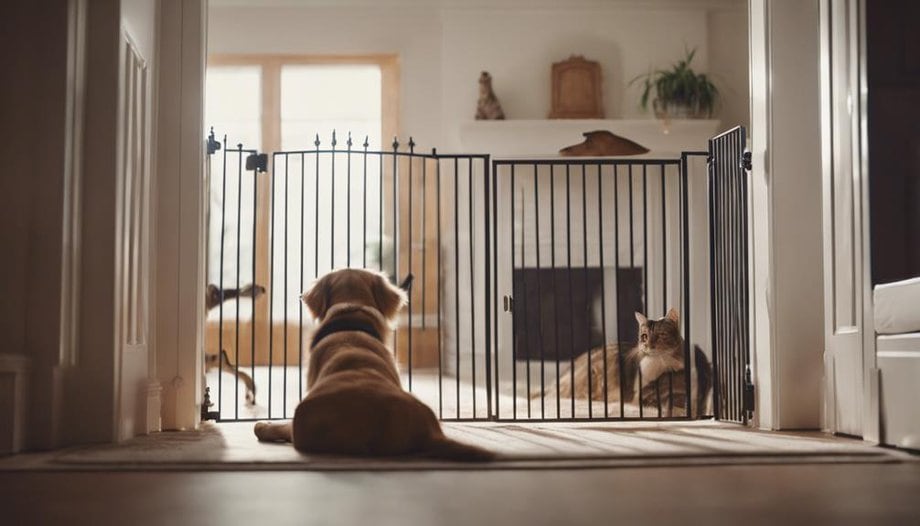
When introducing a cat to a larger animal, such as a dog or another cat, it is important to do so gradually and carefully. Start by keeping them separated and allowing them to become familiar with each other's scent.
Next, you can try feeding them on opposite sides of a closed door so they associate each other's presence with something positive, like food.
Once they seem comfortable with each other's scent, you can try short supervised interactions in a controlled environment.
Always be prepared to separate them if things get too tense, and never force them to interact if they seem fearful or aggressive. With patience and positive reinforcement, many cats can learn to coexist peacefully with larger animals.
Introduction to Socializing Cats With Larger Animals
Socializing cats with larger animals requires patience and gradual introduction to ensure a smooth and safe interaction. When introducing cats to larger animals, it's crucial to observe their behavioral cues for signs of stress or aggression. Socialization strategies should focus on positive reinforcement, using treats and praise to encourage calm behavior.
One effective approach is to start by keeping the animals separate but allowing them to smell each other's scent through a closed door. This helps them become familiar with each other's presence without direct contact. Gradually, supervised face-to-face interactions can be introduced in short sessions, monitoring their body language closely for any signs of tension.
Challenges may arise during the socialization process, such as one animal displaying dominance or fear-based aggression. In such cases, it's essential to intervene calmly and redirect their focus to positive interactions. Consistency, patience, and rewarding good behavior are key to successful animal introductions.
Understanding Your Cat's Behavior
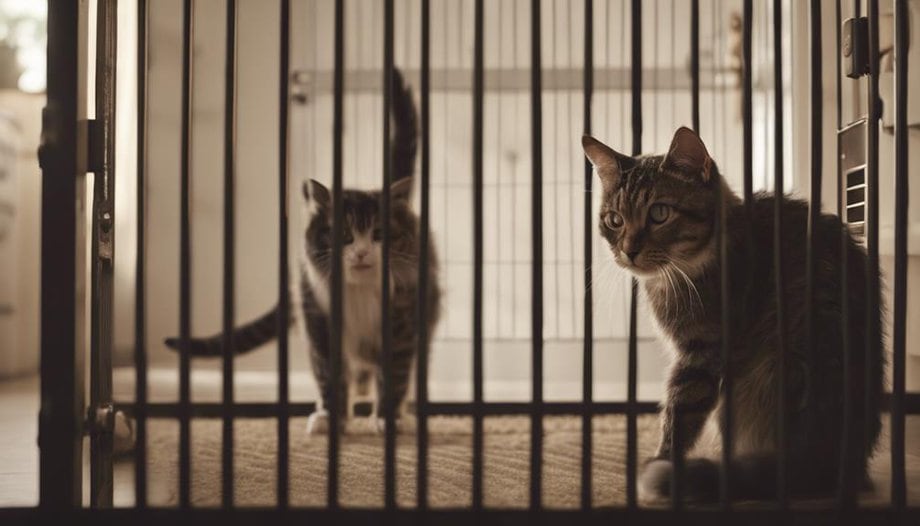
Understanding Your cat's behavior is crucial when introducing them to larger animals.
By recognizing cat body language, social cues, and stress signals, pet owners can better navigate socialization efforts.
Being attuned to these behaviors can help prevent conflicts and ensure a smoother introduction process.
Cat Body Language
To better comprehend your cat's behavior, observe and interpret their body language cues carefully. Understanding feline communication is crucial in deciphering what your cat is trying to convey.
Cats use various body signals to express their emotions, such as arching their back when feeling threatened or purring when content. Pay attention to their tail position, ear movements, and overall posture to gauge their mood accurately.
For instance, a cat with flattened ears and dilated pupils may be agitated or fearful. On the other hand, a cat with a relaxed posture and gently twitching tail is likely feeling calm and content.
Cat Social Cues
Observing your cat's body language can provide valuable insights into their social cues and behavior. Understanding feline communication and animal dynamics is crucial when socializing cats with larger animals.
Here are some tips to help manage your cat's behavior effectively:
- Give them space: Cats often need their own territory and may become stressed if they feel crowded.
- Use positive reinforcement: Reward good behavior to encourage positive interactions with other animals.
- Monitor their interactions: Keep an eye on how your cat interacts with larger animals to prevent any potential conflicts.
- Provide hiding spots: Cats feel more secure when they've places to retreat to if they feel overwhelmed.
- Seek professional advice: If you encounter difficulties in socializing your cat, consult with a veterinarian or animal behaviorist for guidance.
Cat Stress Signals
By recognizing subtle signs of stress in your cat, you can better understand their behavior and address potential issues when socializing with larger animals. Understanding your cat's stress signals is crucial in managing introductions to prevent any negative interactions.
Cats may exhibit stress through behaviors like excessive grooming, hiding, aggressive posturing, or excessive vocalization. These signals can indicate that your cat is feeling overwhelmed or anxious in a social situation, signaling the need for intervention.
When introducing your cat to larger animals, closely monitor their body language and responses to ensure a safe and positive interaction. By being attentive to these stress signals and managing introductions carefully, you can help your cat feel more comfortable and secure when socializing with larger animals.
Preparing the Environment for Interaction
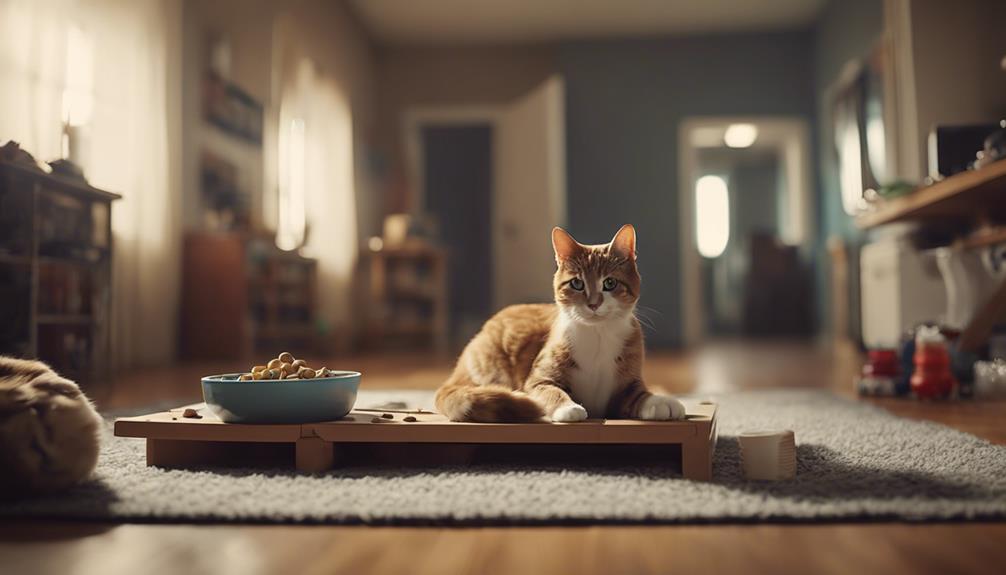
Creating a safe and comfortable environment is crucial when introducing cats to larger animals for socialization. To prepare the environment effectively, consider the following:
- Setting Boundaries: Establish clear boundaries using baby gates or closed doors to separate the animals initially.
- Creating Safe Spaces: Provide each animal with their safe space equipped with food, water, litter boxes, and comfortable bedding.
- Removing Hazards: Ensure the area is free of potential dangers such as small objects, toxic plants, or sharp items.
- Using Vertical Space: Cats feel secure when they can perch up high, so offer cat trees or shelves for them to climb.
- Providing Hiding Spots: Offer hiding spots like boxes or tunnels where cats can retreat if they feel overwhelmed.
Supervising the Initial Encounters
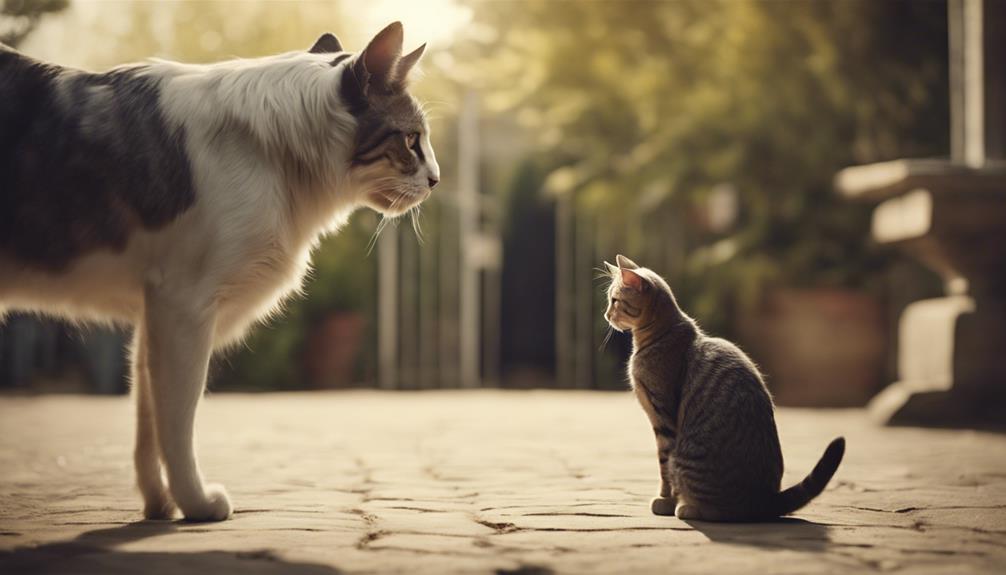
When introducing cats to larger animals, it's essential to closely monitor their initial interactions to ensure safety and positive outcomes. Establishing a supervision protocol is crucial in overseeing these encounters effectively.
Begin by introducing the animals in a controlled environment where their interactions can be observed closely. Keep the initial meetings short to prevent overwhelming either animal and gradually increase the duration as they become more accustomed to each other.
Implement safety measures such as using a sturdy barrier or leash to maintain distance and prevent any potential aggressive behavior. Watch for signs of stress or aggression, and if any negative behavior is displayed, separate the animals immediately.
During these interactions, provide positive reinforcement for good behavior to encourage a harmonious relationship between the cat and larger animal. By following a structured supervision protocol and incorporating safety measures, you can help facilitate a successful introduction between your cat and larger animal.
Training and Positive Reinforcement Techniques
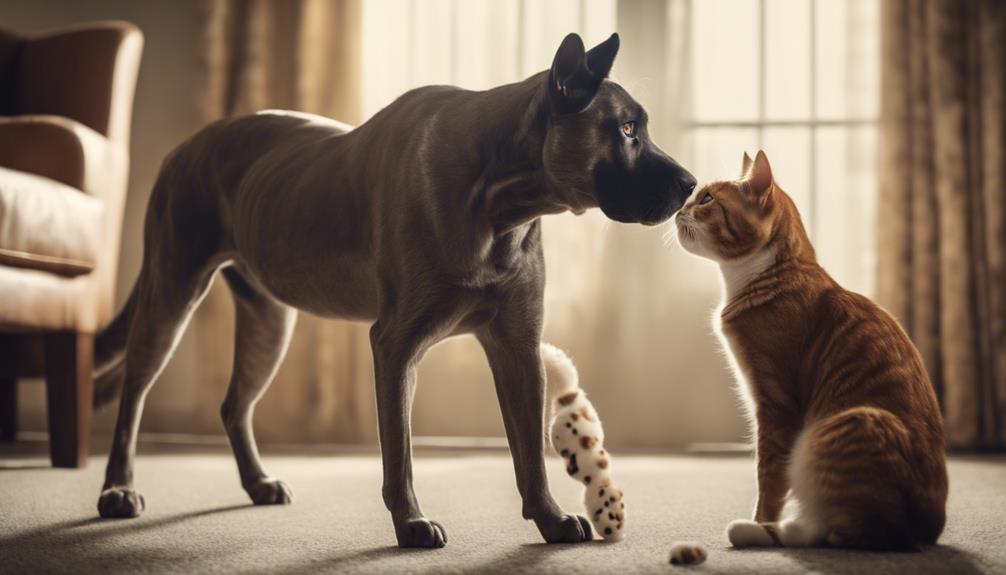
To effectively train and reinforce positive behaviors in cats socializing with larger animals, utilize consistent and reward-based techniques. Behavior modification techniques can be beneficial in encouraging desired behaviors and discouraging unwanted ones. Reward-based training focuses on positive reinforcement, rewarding the cat when it displays the desired behavior.
Here are some key points to consider when training cats to socialize with larger animals:
- Consistency: Maintain a consistent training schedule to help the cat understand expectations.
- Patience: Be patient with the cat during the training process, as it may take time for them to adjust to socializing with larger animals.
- Use of Rewards: Use treats or other rewards to reinforce positive behaviors and incentivize the cat.
- Avoid Punishment: Avoid using punishment-based methods as they can lead to fear or aggression in the cat.
- Professional Guidance: Consider seeking advice from a professional trainer experienced in behavior modification for additional support.
Addressing Signs of Stress or Aggression
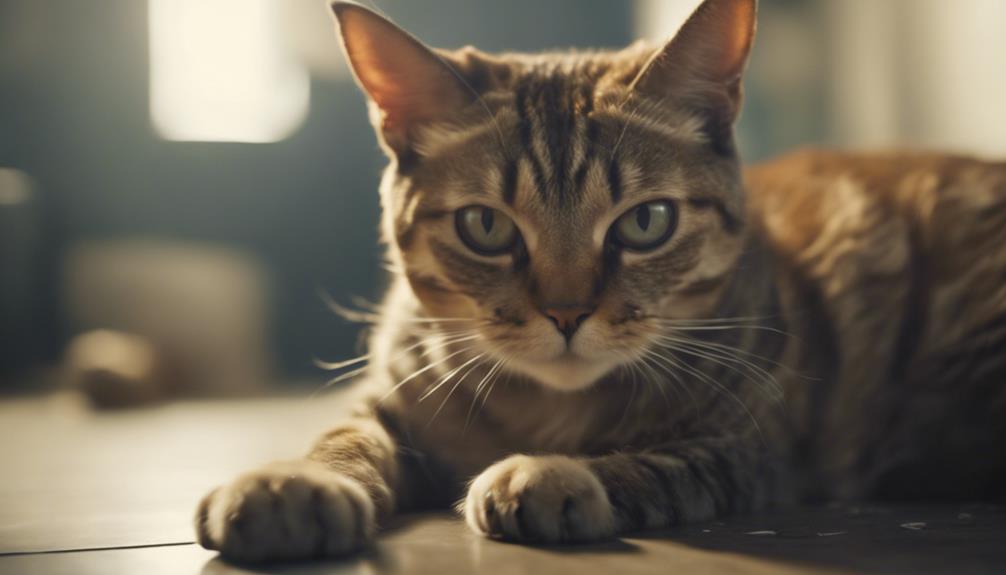
Addressing signs of stress or aggression in cats socializing with larger animals requires keen observation and prompt intervention. It is crucial to identify triggers that may cause stress or provoke aggressive behavior in either the cat or the larger animal. By managing reactions effectively, potential conflicts can be minimized, creating a safer environment for both pets.
| Identifying Triggers | Managing Reactions |
|---|---|
| – Loud noises | – Provide separate spaces for each animal to retreat to if needed |
| – Sudden movements | – Use positive reinforcement techniques to reward calm behavior |
| – Crowded environments | – Monitor body language and vocalizations for signs of distress |
Recognizing early signs of stress or aggression, such as hissing, growling, or flattened ears, is essential for proactive intervention. If any of these behaviors are observed, it is advisable to separate the animals and allow them to calm down before reintroducing them in a controlled manner. Consistent training and supervision are key to fostering a harmonious relationship between cats and larger animals.
Seeking Professional Help and Support
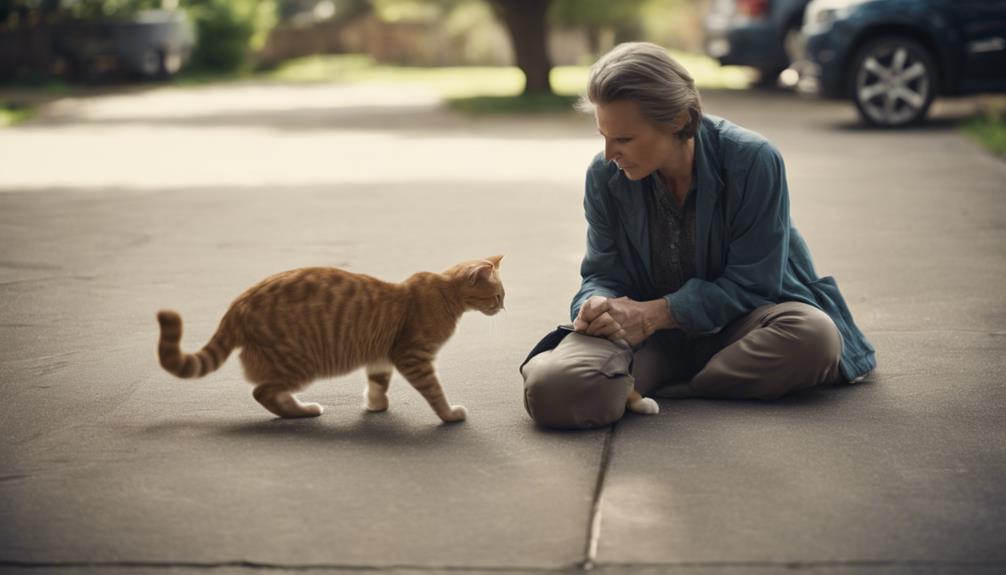
Seeking professional help and support is crucial when integrating cats with larger animals. Professional guidance is essential to ensure the safety and well-being of all pets involved.
It's important to seek expert advice and support from professionals who specialize in animal behavior and introductions.
Professional Guidance Essential
Professional guidance is crucial when socializing cats with larger animals to ensure a safe and successful integration process. Behavior experts can provide valuable insights into feline and larger animal behavior, facilitating a smoother introduction. Pet introductions should be supervised by professionals to prevent potential conflicts and ensure the safety of all animals involved. Seeking expert assistance early on can help identify any potential challenges and address them effectively. Professional guidance also helps in creating a structured socialization plan tailored to the specific needs of the animals.
- Behavior experts offer insights into animal behavior.
- Supervised pet introductions are crucial.
- Early expert assistance can prevent conflicts.
- Guidance helps in creating a tailored socialization plan.
- Professionals can address any challenges effectively.
Expert Advice Crucial
Obtaining expert advice is crucial when socializing cats with larger animals to ensure a smooth and safe integration process. Animal behaviorists can provide valuable insights into training methods that can help facilitate positive interactions between cats and larger animals.
Understanding cat psychology and utilizing appropriate introduction techniques are key aspects that experts can guide pet owners on. By seeking professional help, individuals can gain a better understanding of their pets' behaviors and learn effective strategies to prevent conflicts during the socialization process.
Expert advice not only enhances the safety of the animals involved but also promotes a harmonious environment in which cats and larger animals can coexist peacefully. It's essential to prioritize seeking guidance from professionals to navigate this delicate process successfully.
Support From Professionals
Transitioning from expert advice, pet owners can benefit greatly from tapping into professional support when socializing cats with larger animals for a successful integration process. Seeking expert consultation and assistance can provide valuable insights and guidance tailored to the specific needs of the animals involved.
Some key aspects where professionals can offer support include:
- Behavior Analysis: Professionals can conduct in-depth behavior analysis to understand the dynamics between the animals.
- Training Tips: Experts can provide effective training tips to help the animals adapt to each other's presence.
- Socialization Strategies: Professionals can suggest appropriate socialization strategies based on the animals' temperaments.
- Expert Consultation: Seeking advice from professionals can offer a comprehensive plan for a successful integration process.
- Ongoing Support: Professionals can provide ongoing support and guidance to address any challenges that may arise during the socialization process.
Frequently Asked Questions
Can Cats and Larger Animals Ever Become Best Friends or Will They Always Just Tolerate Each Other?
Cats and larger animals can develop deep bonds beyond mere tolerance. Through playful interactions and understanding each other's communication cues and body language, they can form a relationship based on mutual respect and companionship.
How Long Does It Typically Take for a Cat to Feel Comfortable Socializing With a Larger Animal?
It varies on the socialization timeline for a cat to feel comfortable with a larger animal. Their bonding progress and relationship dynamics play a crucial role. Understanding each pet's pace and providing a safe environment are key factors in fostering a positive interaction.
Are There Any Specific Breeds of Cats or Larger Animals That Tend to Get Along Better?
When it comes to specific breeds, some cats and larger animals surprisingly get along better than expected. Compatibility can vary greatly, impacting socialization progress and bonding concerns. It's essential to observe and intervene if needed.
Should I Be Concerned if My Cat and Larger Animal Don't Seem to Be Bonding Right Away?
If a cat and larger animal don't bond immediately, observing behavioral cues is key. Gradual introduction, professional guidance, and patience are crucial. It's common for them to need time to adjust, seeking help if needed.
What Are Some Signs That Indicate a Successful Socialization Process Between a Cat and a Larger Animal?
When socializing a cat with a larger animal, signs of success include positive body language, gradual progress, and trust-building interactions. Observing their comfort levels and developing a bond over time can indicate a successful socialization process.











